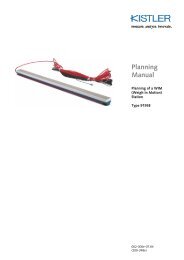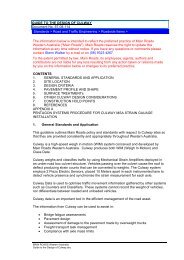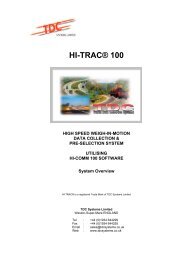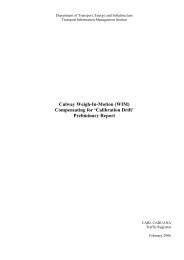AP-G84/04 Best practice in road use data collection, analysis ... - WIM
AP-G84/04 Best practice in road use data collection, analysis ... - WIM
AP-G84/04 Best practice in road use data collection, analysis ... - WIM
You also want an ePaper? Increase the reach of your titles
YUMPU automatically turns print PDFs into web optimized ePapers that Google loves.
Accessed by AR - ARRB TRANSPORT RESEARCH on <strong>04</strong> Feb 2005<br />
7 STAKEHOLDER CONSULTATION<br />
Aust<strong>road</strong>s 20<strong>04</strong><br />
— 49 —<br />
<strong>Best</strong> Practices <strong>in</strong> Road Use Data Collection, Analysis and Report<strong>in</strong>g<br />
Many technical issues have been addressed <strong>in</strong> previous sections. This section is a summary<br />
section that serves to illustrate key components of a best <strong>practice</strong> <strong>road</strong> <strong>use</strong> <strong>data</strong> program. It must<br />
be emphasised aga<strong>in</strong> that many activities require <strong>road</strong> <strong>use</strong> <strong>data</strong> and a diverse group of <strong>road</strong> <strong>use</strong><br />
<strong>data</strong> stakeholders are <strong>in</strong>volved. These stakeholders can be <strong>in</strong>ternal or external to a RA. Examples<br />
of external stakeholders are <strong>road</strong> safety agencies, Local Governments and plann<strong>in</strong>g authorities.<br />
As such, <strong>road</strong> <strong>use</strong> <strong>data</strong> is a corporate asset that requires its share of corporate plann<strong>in</strong>g and<br />
management. The follow<strong>in</strong>g model developed by Mihai (20<strong>04</strong>) for Ma<strong>in</strong> Roads WA is <strong>use</strong>d for<br />
illustration and is shown <strong>in</strong> Figure 17.<br />
The governance structure <strong>in</strong> Figure 17 aims to br<strong>in</strong>g together all parties <strong>in</strong>terested <strong>in</strong> <strong>road</strong> <strong>use</strong> <strong>data</strong><br />
<strong>collection</strong>, and ensures their needs are considered. District or regional <strong>in</strong>terests with<strong>in</strong> a RA must<br />
be represented. A good governance structure should facilitate secur<strong>in</strong>g corporate support. Such a<br />
structure would <strong>in</strong>clude the follow<strong>in</strong>g three groups:<br />
Bus<strong>in</strong>ess reference groups that <strong>in</strong>cludes expert practitioners, strategic planners external and<br />
<strong>in</strong>ternal to a RA;<br />
A steer<strong>in</strong>g committee that <strong>in</strong>cludes an RA’s corporate executives; and<br />
Cross-regional team that <strong>in</strong>cludes representatives from regions and districts <strong>in</strong> a RA.<br />
With a governance structure <strong>in</strong> place, a <strong>road</strong> <strong>use</strong> <strong>data</strong> plann<strong>in</strong>g and management process can be<br />
put <strong>in</strong>to operation. Such a process consists of six key elements as shown <strong>in</strong> Figure 17. The<br />
process is an on-go<strong>in</strong>g process with regular reviews and updates. Some of the elements have<br />
been mentioned <strong>in</strong> previous sections and brief descriptions are given below.<br />
(a) Stakeholder consultation – a register of stakeholders should be kept and their needs <strong>in</strong> terms<br />
of <strong>data</strong> types and formats periodically updated. Ma<strong>in</strong> Roads WA conducts comprehensive<br />
stakeholder consultation every five years. The needs can have priorities set at various levels<br />
to determ<strong>in</strong>e fund<strong>in</strong>g priorities.<br />
(b) Data plann<strong>in</strong>g – necessary activities <strong>in</strong>clude the review of needs, review of exist<strong>in</strong>g <strong>data</strong><br />
<strong>collection</strong> sites, sett<strong>in</strong>g (five-year) goals, estimation of costs and benefits, sett<strong>in</strong>g and<br />
updat<strong>in</strong>g of policies on issues such as the level of coverage (Section 4.3), def<strong>in</strong><strong>in</strong>g a uniform<br />
traffic section (Section 4.3) and <strong>data</strong> quality (Section 6).<br />
(c) Budget and programm<strong>in</strong>g – this task <strong>in</strong>cludes prepar<strong>in</strong>g estimates of capital equipment costs<br />
and on-go<strong>in</strong>g ma<strong>in</strong>tenance costs, roll<strong>in</strong>g programs over, say, five years accord<strong>in</strong>g to different<br />
scenarios (outsourced, <strong>in</strong>-ho<strong>use</strong> or a comb<strong>in</strong>ation), <strong>data</strong> process<strong>in</strong>g costs, and costs of<br />
monitor<strong>in</strong>g count<strong>in</strong>g sites periodically.<br />
(d) Data management – this process is as described previously on the <strong>collection</strong>, validation,<br />
process<strong>in</strong>g, <strong>in</strong>tegration and storage.<br />
(e) Data delivery – after <strong>data</strong> management, the key issue is facilitat<strong>in</strong>g the efficient and effective<br />
delivery of <strong>data</strong> to <strong>use</strong>rs. The tasks of <strong>data</strong> report<strong>in</strong>g and accessibility have been discussed<br />
<strong>in</strong> earlier sections. In particular, a public-private partnership could be an important means to<br />
make <strong>data</strong> more accessible. Tra<strong>in</strong><strong>in</strong>g sessions on <strong>data</strong> usage should be provided.<br />
(f) Review and audit – reviews and audits of the <strong>data</strong> under management are part of a corporate<br />
process. Feedback <strong>in</strong> the form of stakeholder surveys should also be considered.

















